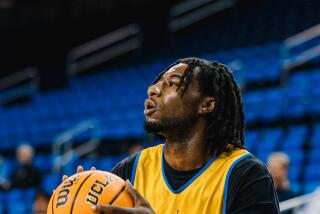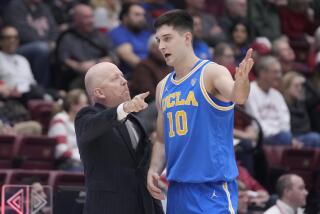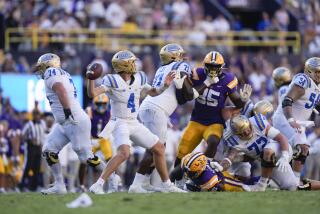This UCLA Team Is Full of Blue Grit
The story of UCLA’s return to college basketball glory begins with a classic image: a boy spending hours on the court, determined to succeed.
This wasn’t some future superstar honing his jump shot. It was a coach-in-the-making -- Ben Howland -- learning an important lesson about how to win.
“I grew up playing one-on-one at the Boys’ Club,” Howland said. “If you didn’t play defense, you lost.”
All week long, with UCLA back in the Final Four after 10 years of falling short, much has been made of the Bruins’ coarse style under Howland, in his third season as Bruin coach. The way they scramble for each point, grapple for each rebound, hound opponents defensively, has been called ugly if not worse. Howland prefers “lunch pail, bring your hard hat” basketball.
His approach might come as a jolt to Southern California fans raised on the glitzy, fastbreaking Lakers and the legend of previous UCLA teams that, under John Wooden, dominated with crisp offense and superstars in the lineup. Some have questioned whether this brand of basketball can be popular in a city where entertainment is serious business.
The story of UCLA’s return to prominence is about a program that grew tired of waiting for a high-scoring savior. It is about a group of players viewed as underachievers and a coach predisposed to choose an alternate route.
“The bump and grind of it, the physical play of it,” Memphis Coach John Calipari said last weekend after UCLA dispatched his team, 50-45, in the Oakland Regional final, the score more befitting a junior high school game. “When they needed to shut somebody down, they did.”
The Bruins will face Louisiana State in an NCAA tournament semifinal in Indianapolis on Saturday evening, one victory shy of the championship game, because their top 10-ranked defense has held opponents to a miserly 58.6 points a game.
The last time the Bruins kept scores so low was 1950, well before the advent of the 35-second shot clock.
For UCLA, the Final Four represents familiar territory if only because the Bruins have won a record 11 national titles, including seven in a row during the late 1960s and early ‘70s. But they haven’t advanced this far since their last championship in 1995, a gap that spelled bitter disappointment.
Season after season, fans looked to recruits for a reincarnation of former standouts such as Walt Hazzard or Bill Walton. Winning records and Pacific 10 Conference championships offered little solace.
“At UCLA,” point guard Jordan Farmar said, “no other banner but national championships go up.”
Which explains how the previous coach, the young and personable Steve Lavin, could guide his teams to the NCAA tournament in six of his seven seasons yet lose his job for failing to go all the way.
Enter Howland, whose preferences tended less toward star power, more toward elbow grease.
Not as telegenic as his predecessor, with that stocky build and receding hairline, he carried the lessons from years of playing as a boy in Cerritos and Santa Barbara.
“On offense, you’re going to miss shots and make some bad passes,” he said. “But defense, you always have that to rely on. It’s always there for you.”
As a young head coach at Northern Arizona in the mid-1990s, Howland learned from veteran Utah coach Rick Majerus, studying the Utes’ system. Moving to Pittsburgh in 1999, he emphasized hustle in molding a team that reached the NCAA tournament’s Sweet 16 twice in a row.
Howland sounds like the typical fan when discussing the game. “If you look at all sports, whether you’re talking about the Pittsburgh Steelers or the New England Patriots or baseball, it all starts and ends with defense,” he said. “You need to play defense to have a chance to win championships.”
The East Coast has a long tradition of tough basketball; transferring this style to UCLA posed several challenges.
Howland, who grew up watching the Bruins in their halcyon days, knew he would be working in Wooden’s shadow. He also knew that Lavin had employed something of a freewheeling style.
UCLA forward Cedric Bozeman recalls the new coach arriving in 2003 and quickly laying down the law: Any player who wanted to be on the court had to earn his way with effort.
That first team finished 11-17, but Howland had endured slow starts at Northern Arizona and Pittsburgh. The Bruins improved to 18-11 last season, returning to the NCAA tournament.
They truly hit their stride midway through this season after consecutive losses to Washington and USC. On the ride home from the Trojan game, the bus was silent.
“We got exposed,” guard Arron Afflalo said. “We really looked at ourselves and said, ‘We need to play defense.’ ”
Since then, Afflalo and his teammates have embraced Howland’s philosophy, exhibiting a determined brand of man-to-man defense. They have won 11 consecutive games, limiting all but one opponent to 60 points or fewer.
They also rank among the better rebounding teams in the nation.
“They were really, really pressuring, really climbing up into us,” Gonzaga Coach Mark Few said after UCLA held his team scoreless in the final 3 1/2 minutes of the comeback victory in the regional semifinals last week.
Bozeman and center Ryan Hollins, seniors whose careers had been considered disappointments, now shine in Howland’s system. Afflalo has become a leader -- tireless, quick on his feet, long-armed. The 6-foot, 5-inch sophomore studies opponents’ tendencies and will slap his hands in disgust when scored upon.
“When you’re winning, playing defense and coming to each game with that mind-set becomes easier,” he said. “Once you make it a habit, it’s not as hard.”
Memphis star Rodney Carney said that against UCLA’s pressure tactics, he and his teammates “couldn’t get anything going at all.”
After last Saturday’s win, Howland gave his players an evening to celebrate before getting down to preparations for LSU. He also sought to dispel a couple of widely held notions.
First, he says, UCLA’s return to greatness is not only about hustle.
“It starts with great athletes,” he said. “You can try as hard as you want, but if you don’t have the ability, it won’t work.”
Second, the Southern California native insists that hard-nosed play suits this part of the country just fine. Those famous UCLA and Laker teams were defensively sound, he says. He talks about former NBA players Michael Cooper and Dennis Johnson as “probably the best on-ball defenders except for Michael Jordan, and they were L.A. guys.”
Yet his UCLA squad is more likely to be compared to the tough, gritty Detroit Pistons who won the 2004 NBA championship over the Lakers of Shaquille O’Neal and Kobe Bryant.
In an era of highlight-reel dunks and me-first basketball, the Bruins are similarly known for such unglamorous traits as moving their feet on defense, fighting under the boards and diving for loose balls.
They have taken the unexpected path and, thanks to some hard lessons from their coach, learned that sweat works just as well as style.
“A win is a win,” Hollins said. “It doesn’t matter.”
More to Read
Go beyond the scoreboard
Get the latest on L.A.'s teams in the daily Sports Report newsletter.
You may occasionally receive promotional content from the Los Angeles Times.







